Where Be Me Charleston Crew? Arrrgggg!
Most of what is written about the lives of pirates is myth and legend; but the names of the pirates and period during which they conducted their careers as thieves on the seas is factual. The myths and legends are the culmination of decades of storytelling about their adventures and misadventures. The city of Charles Towne (Charleston) often had confrontations with pirates over the years, falling prey to them in one way or another. The history of the pirates compiled here are those that are documented in the annals of Charleston, SC.
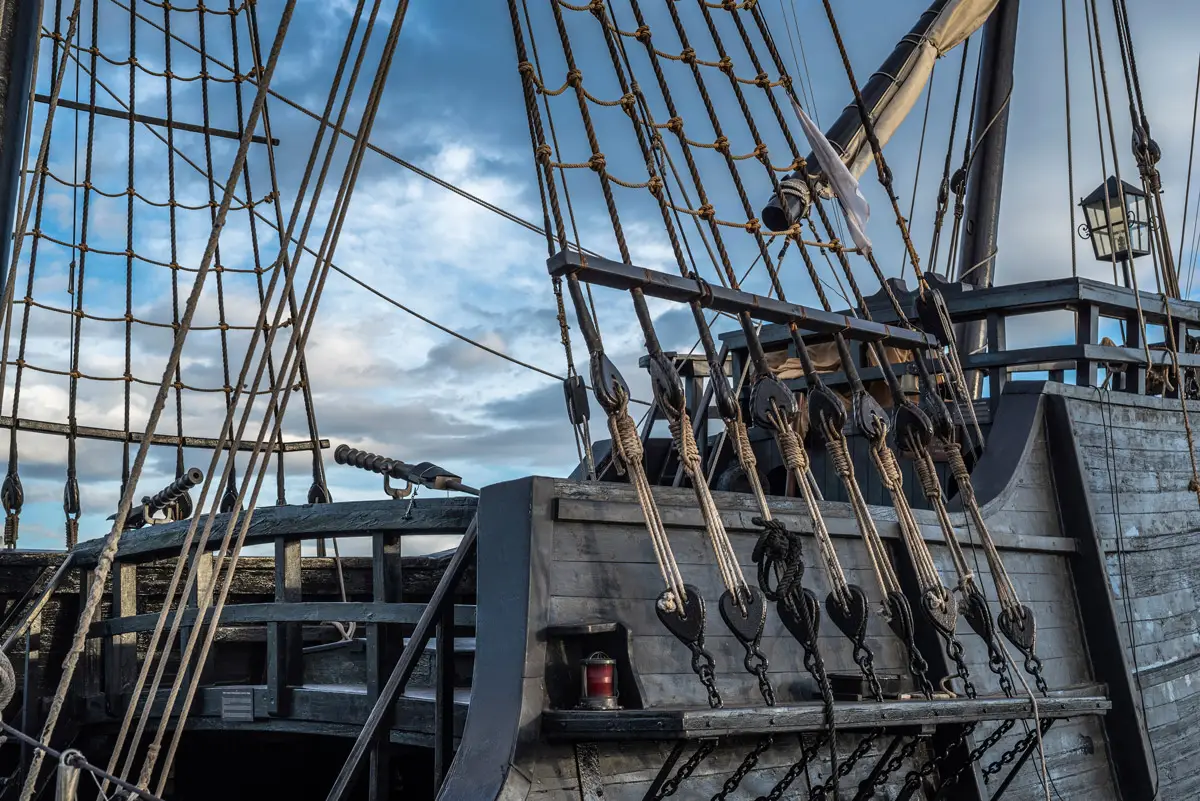
Anne Bonney
Anne Bonney (1698-1782) was an Irish pirate operating in the Caribbean, one of the few female pirates ever recorded in history. She fled Ireland with her mother and her mother’s lover to escape the discovery of her mother’s scandalous affair. They settled on a plantation as a family in Charles Towne, SC.
Not many years after her mother died of Typhoid, Anne became bored with plantation life. Seeking adventure, she married James Bonney, a seaman turned pirate who frequently visited Charleston. He planned to use his marriage to Anne to take possession of the family plantation, but the plan was thwarted. The couple fled to New Providence (Nassau) in the Caribbean, which was a pirate haven during that time in history. Finding her husband cowardly and contemptible, she preferred the company of other pirates on the island and eventually ran away with the pirate “Calico” Jack Rackham and joined his ship’s crew. Rackham seized the schooner William from the New Providence harbor and began pirating merchant vessels along the coast of Jamaica.

Anne proved to be adept in the use of swords and pistols and became a deadly fighter. She reputedly had a violent temper and legend has it that she was also an expert fencer, which she demonstrated when she publicly stripped her fencing instructor with her sword. Anne joined forces with another female pirate, Mary Read, who was disguised as a man on Rackham’s pirate ship and both gained notoriety as bloodthirsty, daring pirates, fighting more courageously than many of the men on board.
The pirate-hunter, Captain Barnet, finally caught up with the William and attacked the ship and captured the pirates following a furious battle. Legend asserts that the two female pirates, Anne and Mary, shot and killed or wounded some of their fellow pirates for cowardice during the battle including Jack Rackham. All were tried and hung except the two women, Anne and Mary, because they claimed to be pregnant and it was illegal to execute a pregnant woman.
Captain Charles Johnson asserts in his book on Pirates (A General History of the Robberies and Murders of the Most Notorious Pirates) that after the trial, Mary was imprisoned and died the following year, while Anne was freed assumedly due to her lawyer father’s influence. Johnson further records that she returned to Charles Towne where she married, had children, and lived out the rest of her life. Other writers of pirate-tales lead one to believe that after being released from prison, the two pirate women disappeared and were never heard from again.
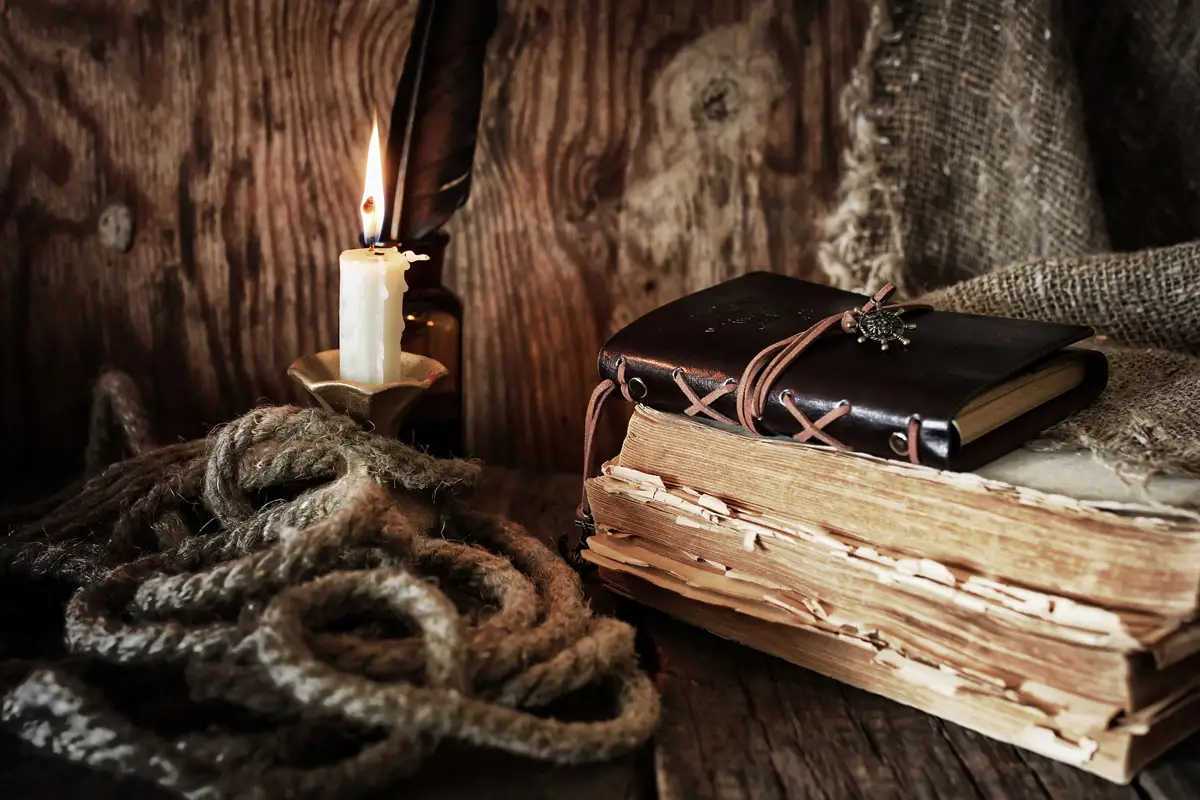
Bartholomew Roberts
Bartholomew Roberts (May 17, 1682 to February 10, 1722) was born John Roberts in Whales. When, at the age of 37, a merchant ship he was on was captured by pirates, he was forced to join them. He quickly learned he could earn more pirating than as a merchant. So, when the captain of the pirate ship and its crew were ambushed and executed, he let the ship to safety and became its new captain. He was the pirate captain of several ships—the “Royal Rover,” “Fortune,” “Royal Fortune,” and “Good Fortune” during the period from 1719 to 1722. Later, after his death, he was nicknamed Black Barty. Barty burned and plundered more than 470 vessels from the West African coasts to the coasts of Brazil, the Caribbean, and as far north as Newfoundland. His death in 1722 during a battle with a British warship pursuing him, culminated what was known as the Golden Age of Piracy from the late 17th century to the early 18th century. Black Barty was known to have captured the most vessels of any pirate in history.
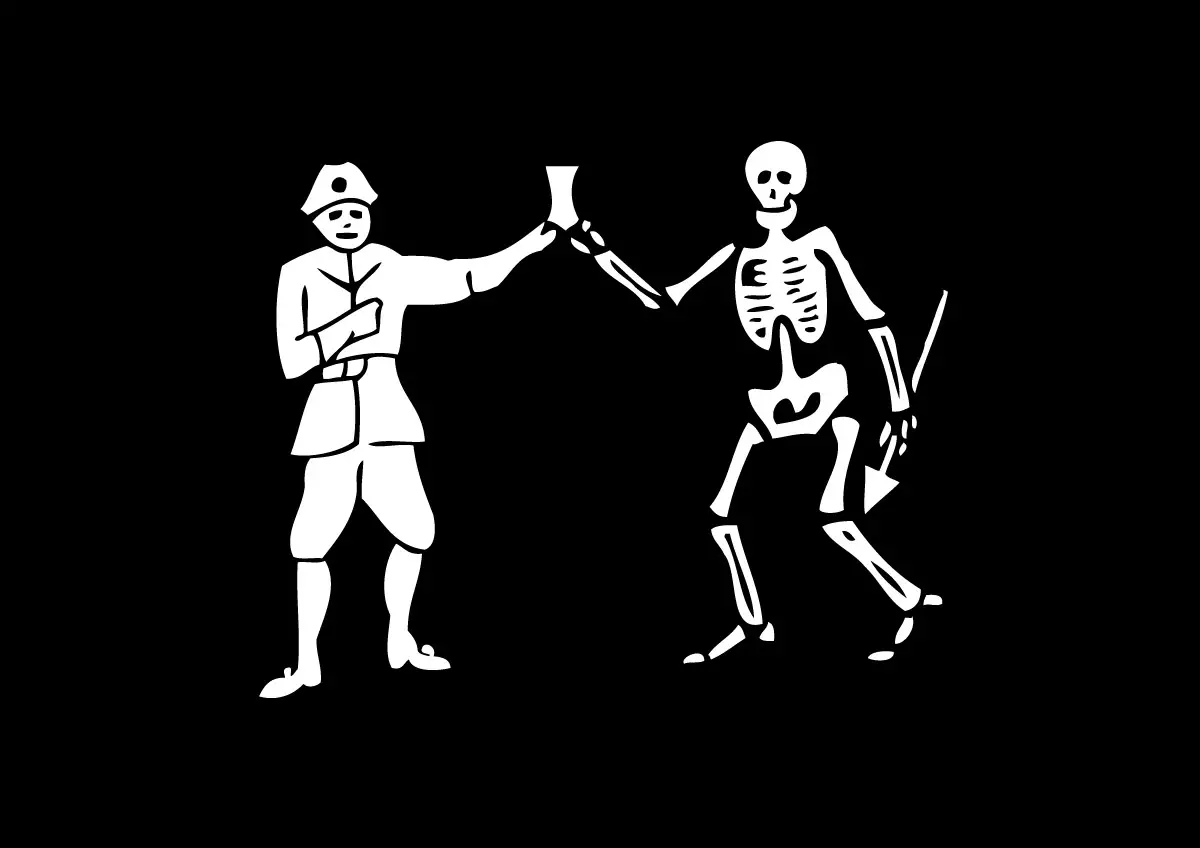
He designed a flag for himself, adopting an early variant of the Skull and Crossbones flag and created his own Pirate Code that was recovered from his ship.
Charles Vane
Charles Vane's pirating career is said to have begun when he joined other pirates in 1716 and lasted only until 1720 when his own shipmates turned on him and put him and his supporters out to sea in a small sloop. He started a successful pirating carrier again from scratch, being able to escape pursuers by out-sailing or outwitting them. But when his vessel was caught in a storm and shipwrecked on an uninhabited island in the Caribbean, it led to his demise. Vane and his men were rescued; but when it was learned that they were pirates, the captain turned them in to authorities in Jamaica. Vane was tried for piracy, convicted, and hanged.

Edward Low (Lowe, Loe)
Edward "Ned" Low (1690–1724) was illiterate, born into the extreme poverty of Westminster, London during that era. Early in life, because he was a combative, strong young man, he would often beat up other boys for their money. He grew up to become a gambler known for his brazen cheating and thievery. When he was a teenager, he worked for a few years making and repairing ships’ ropes and rigging but tired of life on the land. Low then signed on board a vessel headed to Honduras to cut logwood. After a dispute with the captain, he was marooned along with other malcontents. He and the others captured a small boat, and thus began his career as a pirate.
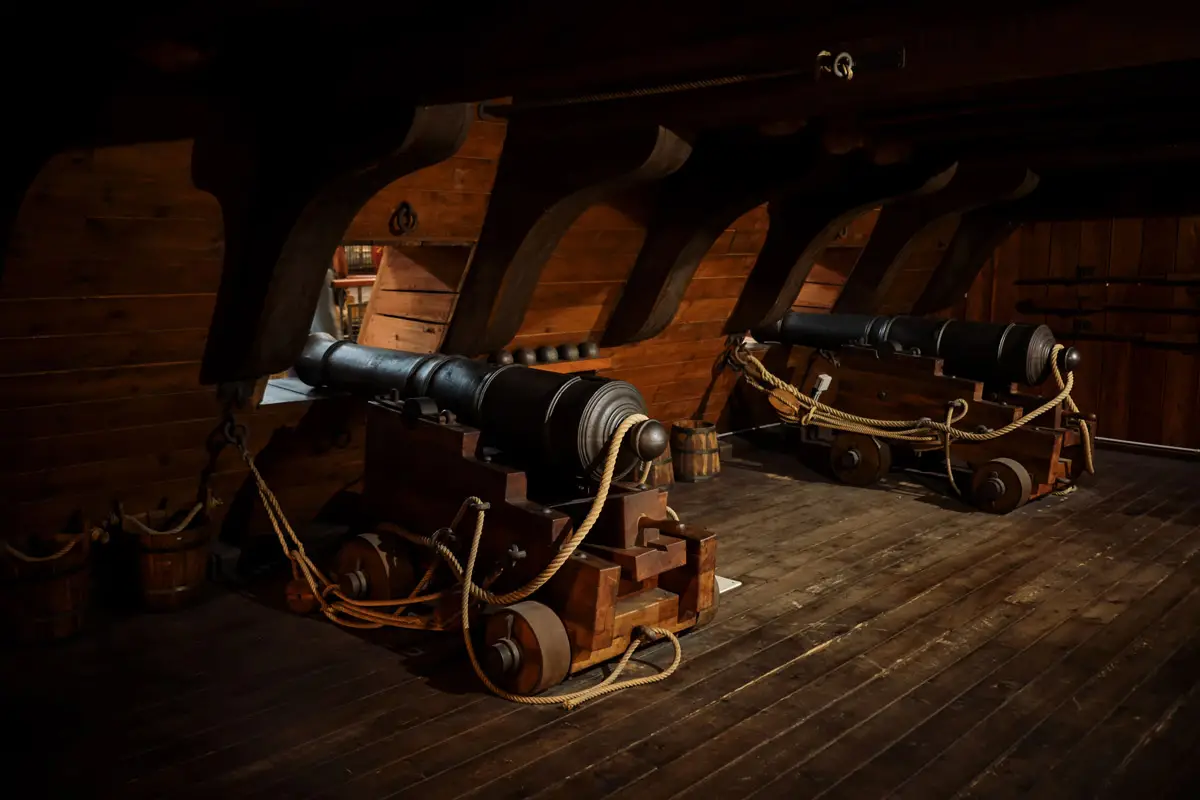
He met up with the pirate George Lowther, captain of “Happy Delivery” who invited Low and his companions to join forces with his crew. Lowther made Low a lieutenant and soon after plundering a 200-ton ship and several other ships, Low was promoted to captain of a captured sloop having 18 cannons. They went on to capture many merchant and trading vessels. In May 1722, Low and Lowther decided to part ways. Low was then captain of a ship with two cannons and four swivel guns with 44 men serving under him. Low became one of the most successful and feared pirates in the world, known for his viciousness and brutality and quickly developed a reputation for torture with the prisoners he captured. He plundered and destroyed hundreds of ships over the course of his criminal career as an outlaw on the high seas, terrorizing shipping on both sides of the Atlantic for a little over two years. His renowned flag consisted of a red skeleton on a black field.
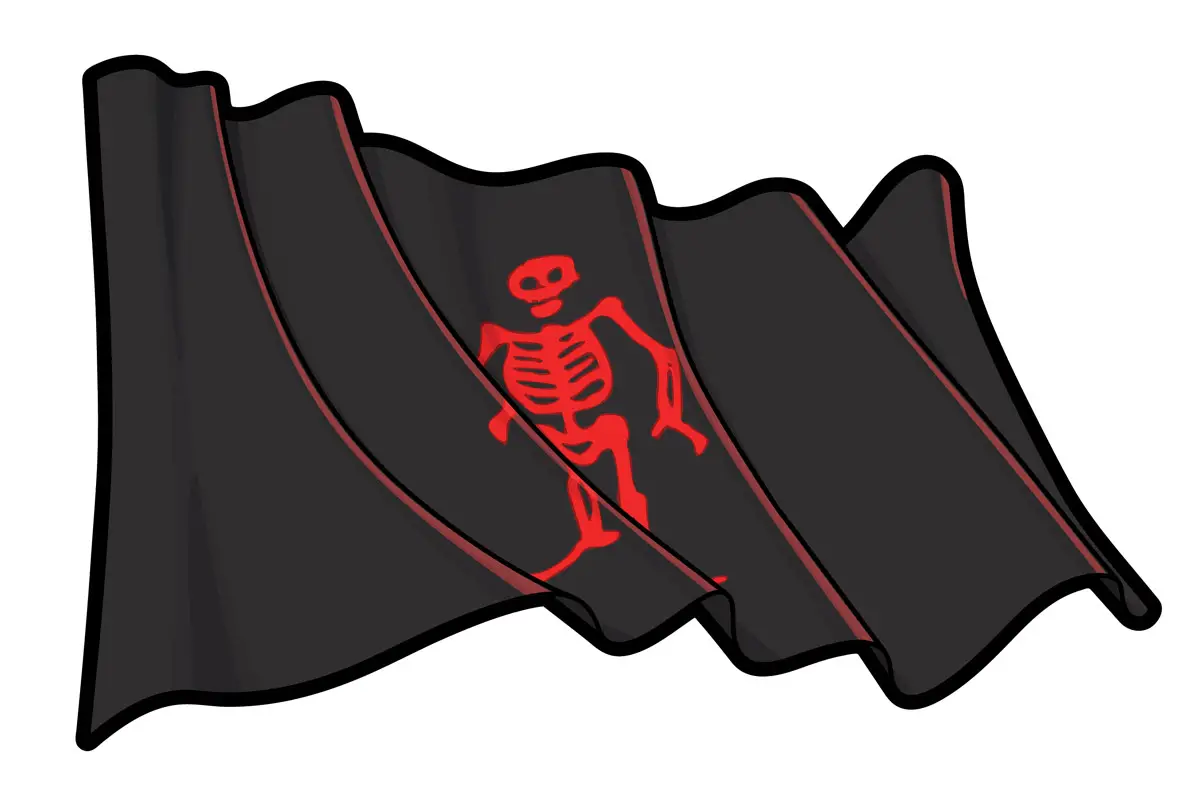
Low was a very clever pirate who only used force when he thought necessary. He and his crew collected a variety of flags from merchant nations, i.e. the flag of Spain, England, or other nations from which he thought their intended prey might originate. Upon approaching the targeted ship while flying a friendly flag, he would begin firing, forcing the ship into surrender. He used only a small fleet to better outmaneuver those he victimized. Low would also use the threat of violence against coastal towns in order to secure needed food, water and supplies or sometimes took hostages making it possible to get his supplies without firing a shot.
In June 1723, Low’s small fleet ran into the 20-gun Greyhound, a Royal Navy ship on the lookout for pirates. The Greyhound shot down the mast of Low’s ship, Ranger, capturing its crew, while Low escaped on the Fancy with much gold. The captured pirates were brought Newport, Rhode Island where most were tried and hung, and some set free because they had been forced into piracy. Low continued his piracy until he and the Fancy were last spotted near the Canary Islands and the western coast of Africa.
Historians don’t know what happened to Low, but no documentation exists to prove he was captured. Some say he spent the rest of his life in Brazil. Another suggests that his crew knew him as the sadistic, lunatic murderer that he was. It is told that his actions became so savage that his crew refused to carry out his orders and they bonded together against Low and set him adrift in a small vessel. Legend has it that he was found by the French and brought to Martinique for trial and hanged. Whatever the cause of his disappearance, by 1725 Low was no longer active in piracy.
Edward Teach – Blackbeard
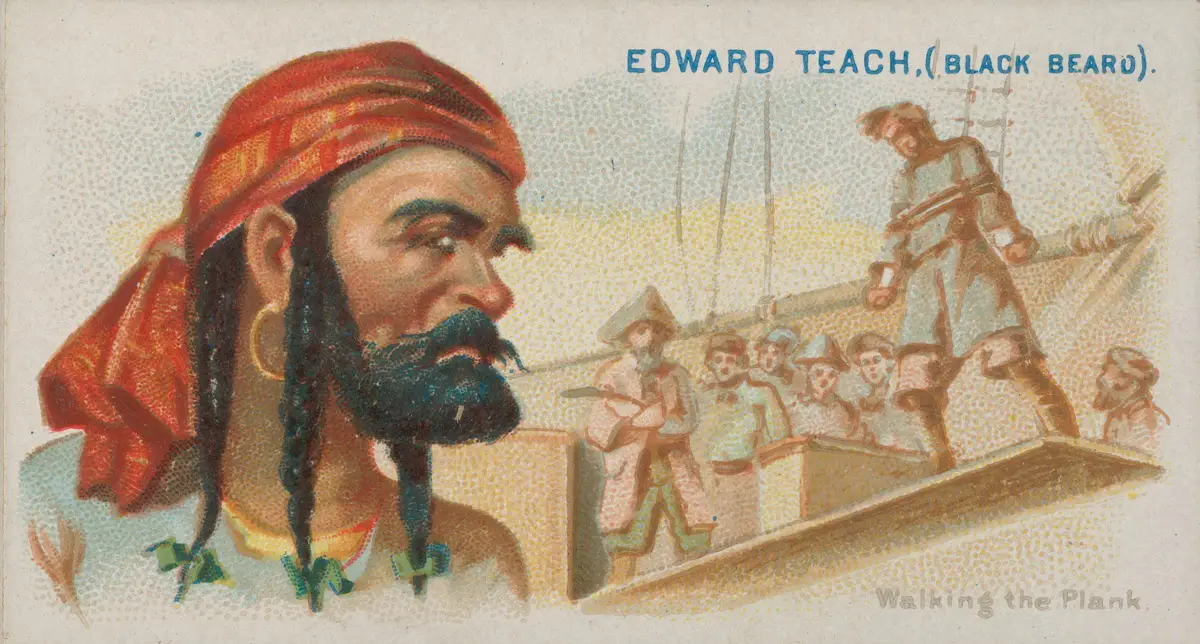
Edward Teach, known as Blackbeard is the pirate best recognized for the “Devil-incarnate” image he himself created. His frightening, menacing appearance was accentuated by his long unkempt hair and beard, twisted into pigtails with colored ribbons on the ends. His persona was intended to frighten the crew of his targeted ships into surrender. During battle, he would even light a slow burning hemp cord under his hat so that smoke would envelope his face in a cloud. He wore as many as six pistols along with knives and a cutlass in his waist band.
Born in Bristol, England around 1680, his true identity is not known, although historians accept his given name as being Edward Teach; but it was apparent that he wanted to keep his identity secret, so Teach might not have been his true name. Unlike most pirates, he must have been a well-educated man who could read and write based upon the papers found on him after his death.

Teach’s pirating career began in 1716 when he met the well-known pirate Benjamin Hornigold who took Teach on as an apprentice. When Teach quickly proved he could perform well, Hornigold gave him his own command of a sloop. Together they wreaked havoc on the seas during his short career as a pirate. Teach took a liking to one captured ship, which Hornigold allowed him to claim as a prize. He renamed it Queen Anne’s Revenge. Teach began commanding the pirate ships on his own since Hornigold decided to retire from pirating when the English King offered a pardon for pirates. Teach's reputation increased dramatically after defeating a British man-of-war.
In May 1718, Blackbeard's pirate fleets began stopping every vessel entering and leaving the Charles Towne, South Carolina Harbor, taking many important, high-ranking citizens as prisoners and held them for ransom. Before the people of Charles Towne could react, almost ten vessels were plundered. Charles Towne diverted all incoming vessels and all vessels already in the harbor were kept in port due to the siege. In order to save the lives of the hostages, they sent the medical supplies demanded by Blackbeard; and, true to his word, Blackbeard released the hostages without loss of life upon receiving his stipulated supplies.

However, in late November 1718, Blackbeard fought his final battle when he encountered another British naval vessel. After a long battle, the commanding officer, Maynard outwitted Blackbeard by ordering most of his crew below decks to bluff Blackbeard into thinking Maynard’s crew was killed. When Blackbeard boarded the ship, Maynard’s crew resurfaced. A raging hand to hand battle ensued, resulting in Blackbeard eventually being overcome. Historians state that Blackbeard was decapitated by a sword during the fighting. Maynard later commented that Blackbeard fell with at least five gunshot wounds and about 20 sword wounds. It is said that Maynard hung Blackbeard’s severed head from his sloop’s bow as a trophy.
Emanuel Wynne (variants - Emmanuel, Wynn)
Emanuel Wynne, a French pirate during the late 17th century to early 18th century, looted and plundered ships mostly in the Caribbean. He began his career as a pirate by raiding English merchantmen off the coast of the Province of Carolina and later moved to the more profitable waters of the Caribbean, attacking both English and Spanish merchant ships.
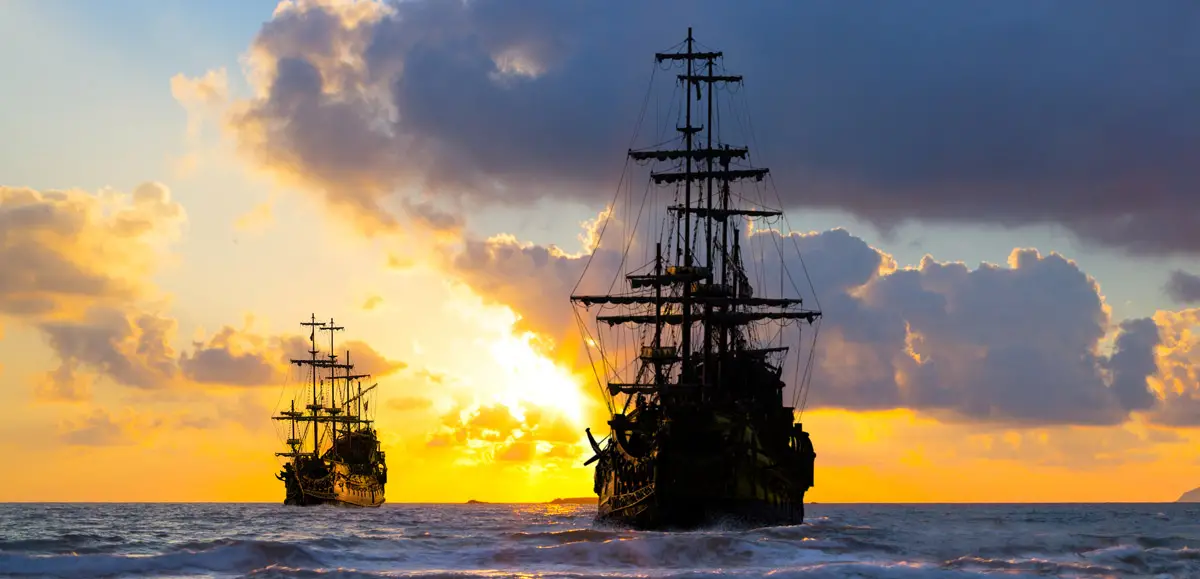
While very little is known about him, it is believed he was the first pirate to fly the Jolly Roger flag, the white skull and crossbones on a black background, but his had an hourglass underneath. The hourglass symbolized the pirate ship’s ultimatum to his prey: “time is running out for the targeted ship to surrender”. The Jolly Roger flag became the standard flag of the Golden Age pirates, late 17th century to early 18th century.
Henry Every or Avery A.K.A. Long Ben, John Avery
The pirate and his exploits about whom books and plays were written is Henry Every (Avery), born in Plymouth, England around 1653. He took to the sea and served on several merchant ships; and when England went to war with France in 1688, he served on ships of war. In 1694, after the war, he became the first mate aboard the Charles II, which was employed by the king of Spain. The mostly-English crew was treated very poorly leading to a mutiny on May 7, 1694 led by Every, after which the men renamed the ship The Fancy and turned to piracy. While Every released a statement declaring that that he would only attack foreigner vessels, he attacked both English and Dutch merchant vessels in the Atlantic off the coast of Africa and in the Indian Ocean as well.

By July of 1695, Every’s The Fancy was part of a fleet of six pirate ships that attacked the Fateh Muhammed, an escort ship to the flagship, the Ganj-i-Sawai. The Fateh Muhammed gave little resistance when attacked and the 50,000 to 60,000 British pounds in treasure on board filled the coffers of the pirates. While it was a large haul, it had to be divided among the crews of six vessels; so, they set their sights on the Ganj-i-Savai, the mighty flagship of Aurangzeb, the Indian Mughal lord. The pirate fleet damaged the Ganj-i-Sawai allowing the pirates to board the ship filled with many passengers, among which were women and a member of the court of the Grand Mughal. Following a fierce battle, the crew and passengers of Ganj-i-Sawai surrendered and were subjected to several days torture and rape by the pirates. It was said to be the richest haul in the history of piracy. Every didn’t want to share the loot with the other pirate ships, so he took off in The Fancy, which was the fastest ship in the fleet with all the treasure and headed for the Caribbean.
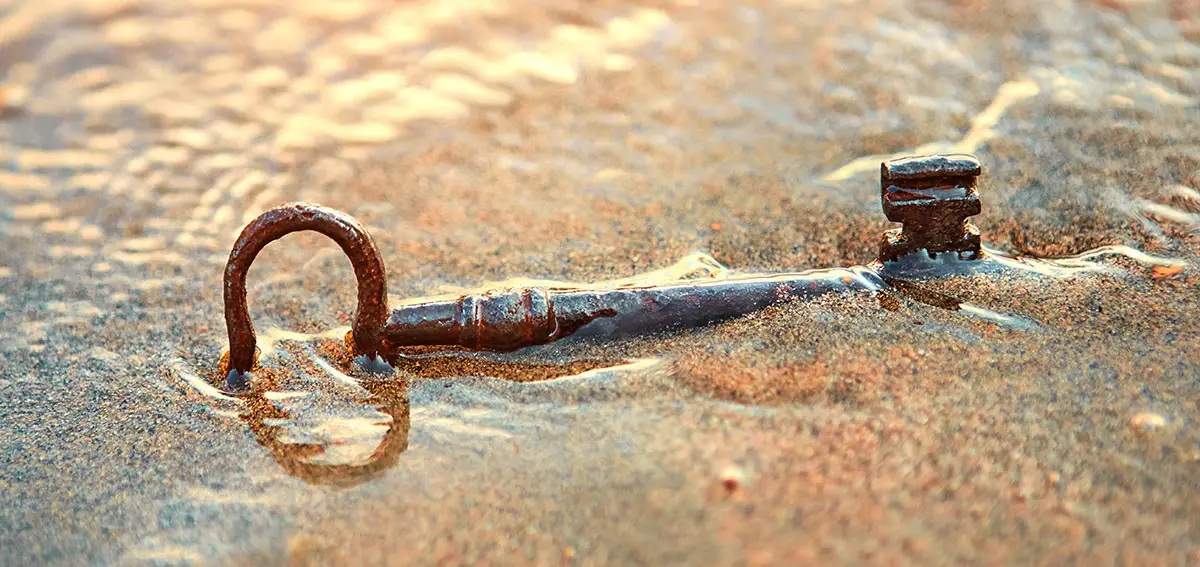
A reward was placed for the capture of Every and the crew of The Fancy. In order to survive, they split up, some went to Charles Towne, SC, some to Ireland, others to England, while some remained in the Caribbean. Every himself seemed to vanish from history at this point. Some historians believe he returned to England and was swindled out of his fortune, dying in poverty.
Richard Worley
In September 1718, Captain Richard Worley, a small-time pirate, set out with eight others from New York in a small open boat that carried few supplies. They subsequently captured a more seaworthy boat and then a sloop from Philadelphia where they took on more pirates. Then they took a better-kept sloop and transferred everything to it.
Worley was able to escape a ship sent out to capture them by heading out to sea. However, his pirating days were shortened when they returned to the Carolina coast six weeks later with an expanded crew and a new vessel on which were mounted six guns. Worley intended to attack merchant ships entering the Jamestown Harbor, but they were spotted by the Governor of the Carolinas who sent two ships to intercept them. Worley ended up trapping himself at the entrance to the Jamestown Harbor where they were broadsided and then boarded by one of the Governor’s ships. All the pirates died in the battle that ensued except two that were captured and hanged the next day, February 17, 1719.
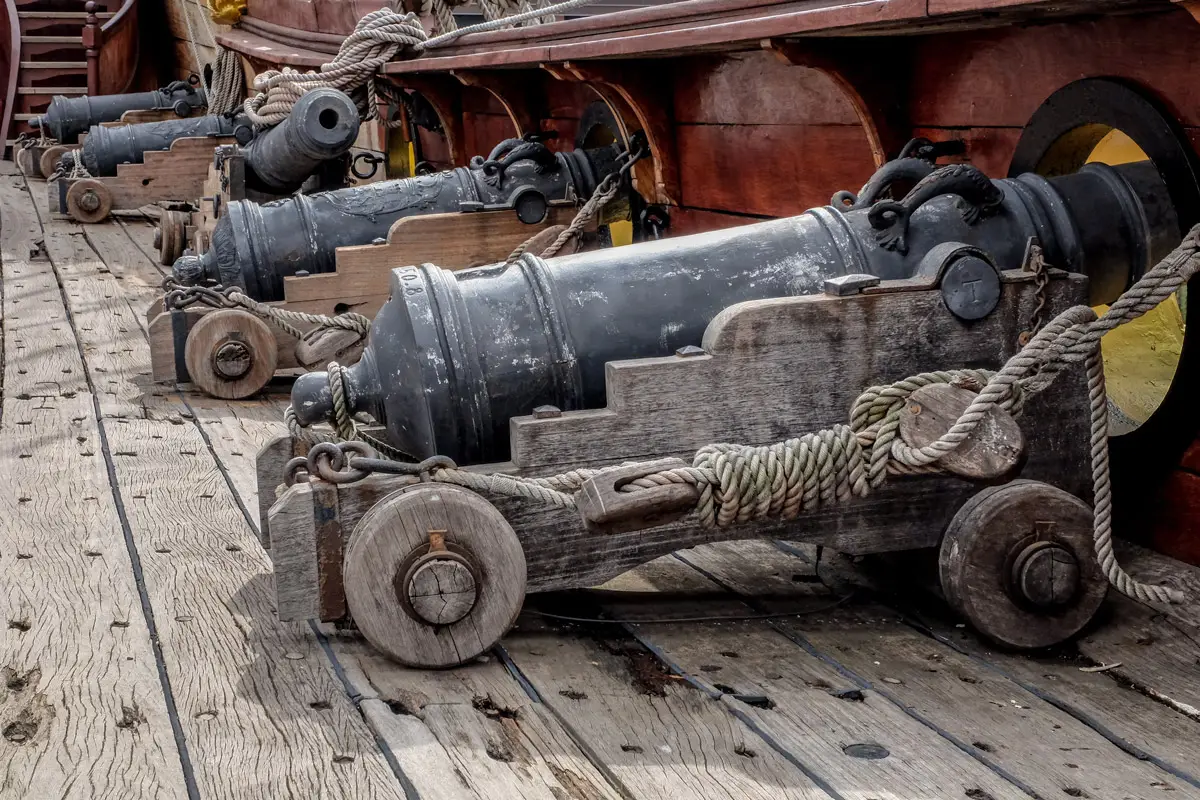
Stede Bonnet
Although mostly uneducated and unemployed seamen joined a pirate ship’s crew, a gentleman Barbadian named Stede Bonnet joined the ranks of pirating.
Stede Bonnet, born in 1688 to a plantation owner in Barbados, was orphaned with his two sisters when both his parents died. Bonnet inherited the plantation; and Guardians made sure he was educated and raised to be a gentleman. Bonnet married Mary Allamby in 1709, also the daughter of a plantation owner and they had three sons and a daughter. He became a major in the island’s militia; and as an upright member of society, he was made a Justice of the Peace. In 1717, Major Bonnet decided to leave Barbados, allowing his wife and two friends to conduct his affairs while he was away. Historians attribute his strange behavior to an unhappy marriage and an unsound mind.
He secretly bought a sloop, named her the Revenge, armed it with ten guns and hired a 70-man crew, saying he would be a pirate-hunter. But instead, he gave up the life of a gentlemen to become a pirate. He was not an experienced seaman and, therefore, had to trust his crew. On its maiden voyage on the Revenge, off the Virginia and Charles Towne coasts, Bonnet captured several vessels of which two came from Barbados. To hide his involvement, Bonnet burned them to prevent word from reaching home and assumed the name Captain Edwards.
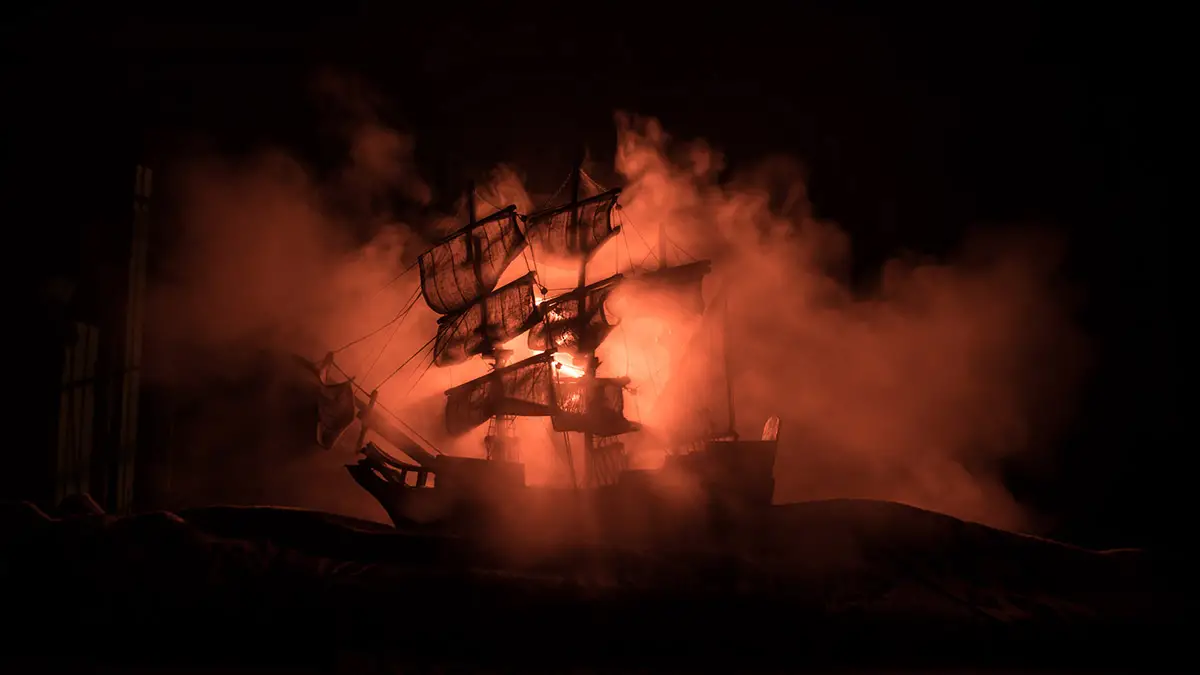
While in the Caribbean, Bonnet came across Blackbeard and formed an alliance with him. But soon after, Blackbeard lured him into giving up command of his Revenge and was given quarters on Blackbeard’s Queen Anne’s Revenge. Blackbeard’s five-ship fleet was eventually used in the siege of Charles Town’s harbor.
During the early years, Charles Towne welcomed pirates into their harbor because pirates provided protection from Spanish ships intending to attack the colony. For the pirates, Charles Town was a haven from which they could raid Spanish ships, and then buy supplies with the gold and silver they had looted. The arrangement didn’t last long, though, when the Crown felt it was a threat to English interests. In fact, they began holding trials for pirates in the colonies instead of in London.
Blackbeard returned Bonnet to the command of the Revenge because he said he was planning to seek a Royal Amnesty that was offered to pirates. Bonnet did the same, but Blackbeard did not. After receiving Royal Amnesty, Bonnet returned to the place where Blackbeard’s fleet was anchored, only to find that Blackbeard was gone with all the plunder. Bonnet soon returned to pirating assuming the name Captain Thomas and changed the name of his vessel to the Royal James.
In 1718, Bonnet captured two merchant sloops and took them to the Cape Fear River. Word reached Charles Towne that pirates had gathered at Cape Fear, so the Governor sent two armed ships under the command of Colonel William Rhett to investigate the report. On September 26, 1718, when Rhett arrived at the Cape Fear, both of his ships ran aground briefly and then dropped anchor for the night. In the meantime, Captain Thomas (Bonnet) prepared for a fight.
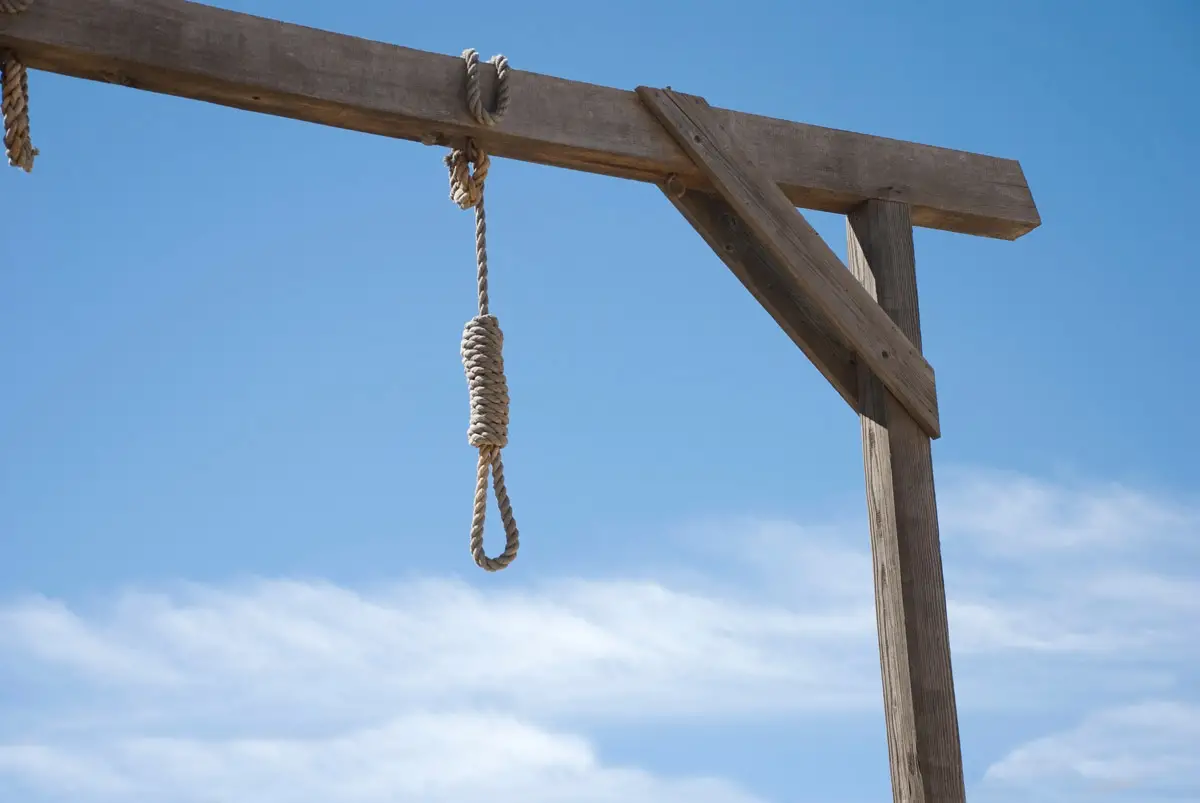
The next day, both of Rhett’s two vessels and Bonnet’s ship sailed into shallow waters and were grounded. Rhett’s men got the advantage during the ensuing gun battle and Bonnet surrendered. When Rhett learned that Captain Thomas was actually Stede Bonnet, he and his men were taken to Charles Towne. Bonnet, being a gentleman, was taken to the house of the provost-marshal who was a Barbadian. Bonnet escaped and the provost-marshal was dismissed for being suspected of aiding in Bonnet’s escape. Most of Bonnet’s men were convicted of piracy and sentenced to death. Bonnet was soon recaptured and after only short life of pirating, was hanged on December 10, 1718 and his body buried beyond the low-water mark. Stede Bonnet is remembered as “The Gentleman Pirate.”
Thomas Tew (1649 – 1695)
Born in 1649 into a wealthy family of Newport, Rhode Island, Thomas Tew was a 17th Century English privateer-turned-pirate. Privateers were a type of pirate whose actions were deemed legal when authorized by the government of a country or by a group or trading company issuing Letters of Marque and Reprisal documents guaranteeing that the privateers would not be held accountable when they destroyed vessels of an enemy of a nation or group and seized their valuables. They acted as navy soldiers, in a way.

The “privateer” represented the captain, the owner of a ship, the crew or even the vessel itself. All involved benefited and some found it be an exciting job since they could attack ships and ports without fear of punishment from their sponsors. The government or group sponsoring them did not have to pay for their services and the privateers, in turn, gave back a percentage of their plunder in exchange for their immunity.
Tew served as a privateer on English ships and soon became captain of Amity Venture, a vessel purchased through donations. The Governor of Bermuda gave him permission to attack French ships and colonies on the African coast and was scheduled to join with a Captain George Drew to attack a French factory on the shores of Gambia. When Drew’s ship was damaged in a storm before they could meet and carry out the plan, Tew decided to withdraw from the venture and become a pirate, to which his crew heartily agreed.

Victims of Tew’s pirating often surrendered immediately when they learned the identity of the attacker since Tew was known to be kind. He became famous for two major pirate journeys, during which he seized a fortune equal to $112.8 million U.S. dollars.
During the first famous pirating journey in 1693, Tew and his crew attacked an Indian cargo ship with more than 300 soldiers plus seamen. After short battle, Tew and the crew of Amity Venture were victorious and each of his men shared in the great spoils of gold, silver, gems, ivory, silk, and spices. This is where Tew obtained the majority of his wealth. For a period of time, Tew and his crew retired comfortably to the island of Madagascar. But shortly, Tew became restless and sailed for Rhode Island to obtain a pardon, which was granted.
He lived there for a while, but the lure of piracy was irresistible. As a result, in 1695 Tew took command of a pirate ship and sailed to the Red Sea where he met his fate on his second famous and final pirating journey. He attacked a well-armed ship belonging to the Great Mogul. The ensuing battle left Tew mortally wounded, being disemboweled by cannon fire. The shocked crew surrendered without resistance. Most of them were immediately executed and the rest were taken to prison in India where they died.
Tew was one of the richest pirates in history and probably the best-liked for his affable nature.

Did we leave out any Charleston SC Pirates? Let us know.
Want to get out on the open sea?
